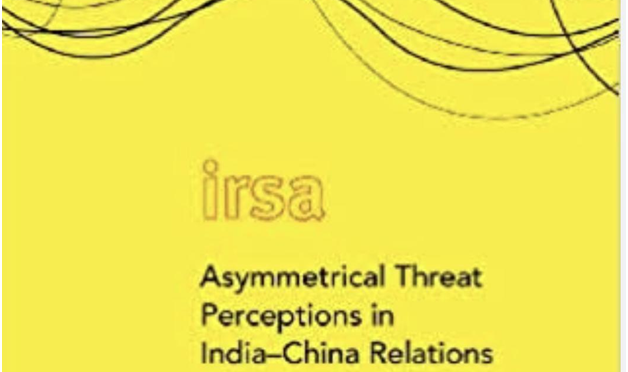Asymmetrical Threat Perceptions in India–China Relations
Posted on : April 20, 2023Author : Kanak Mohley

Title: Asymmetrical Threat Perceptions in India–China Relations
Author: Tien-sze Fang,
Edited by: Sumit Ganguly, E. Sridharan
Publication Date: Oxford University Press, 2014,
Length: 250
Price: ₹795
India and China started to develop at the same time. However, as a cumulative outcome of China’s policies, system of government, innovation and technological advancements China soon raced ahead of India in the developing regime. The relationship between the two countries has not always been smooth. Tien-sze Fang through his book ‘Asymmetrical Threat Perceptions in India–China Relations’ attempts to make a comparative study of the nature of threat perceptions in both the countries.The interactions between the two strong Asian powers not only exerts a profound and far-reaching influence over regional security but also act as a decisive factor in the shaping of international order. To shed light on this essential relationship, the book provides a new perspective for understanding India-China relations by highlighting the asymmetry of the threat perceptions. The aim of the book is to understand how these countries look at each other in terms of political and security influences and how they react in terms of policy and implementation. Conversations around non-traditional and asymmetrical threats in these countries was the need of the hour when the book was published by Oxford University Press in 2014.
Fang has examined in great detail the major issues of India-China relations, including the nuclear issue, the boundary problem, the Tibet issue, regional competition and cooperation, and India-China relations in the global context. Although India and China are close geographically, the ideological distance between the two countries is vast. The book draws on evidence from interactions between India and China over the past years to make an empirical case for the existence and impact of asymmetrical perceptions of threat between the two countries. The author has been specific and ensured that he does contradict himself at any point. This book endorses the view that although both the countries have security concerns and keep a harsh eye on each other’s movements, the threat perception in India towards China is far more acute than in the latter. Citing the 1962 war as a ‘fixed’ and ‘the main source’ of India’s perceived threat from China, the author argues that the memories of war have shaped India’s threat perceptions. At the same time, both countries prefer to take the rational road and prefer soft and subtle balancing of power – evidently there is a constant pursuit of power between the two nations and each is developing itself more and more, either economically or militarily, in order to assert their dominance in the region. The author explains that while Chinese perception of India’s security environment is evolving favorably, China finds it difficult to understand why India might perceive China as a threat. This is clear from the opening argument where Fang explains the rise of nuclear programmes in the two regions. China’s perception of a nuclear threat was shaped by the United States and the Soviet Union and India was not a consideration for the same. However, as a result of the security dilemma spiral faced by India, the possession of nuclear power by China was one of the major motivations for India to develop its own nuclear programme. Butterfield’s idea of fear and universal sin plays an active role here. It is important to understand, as explained in the book, that India may not as such be worried that China poses a nuclear threat, but it has always believed that nuclear blackmail by China in a 1962 war-type exigency is a big possibility. In order to be able to retaliate, India made itself stronger, fitting itself under the ideas of “Cooperation under the Security Dilemma” as explained by Robert Jervis. However, through global corporations at various international organizations, it has been made clear that the two countries do not want to see each other in a confrontational relationship.
The book is written in a comprehensive and coherent manner. The author has ensured that he covers all themes from multiple perspectives. You will find a historic timeline of events coupled with strategic commentary and operational importance of the subject. Chapters like ‘Regional Competition and Cooperation’ and ‘The Sino – Indian Border Problem’ also have some personal stories and perspectives which keeps the reader glued till the end. The easy vocabulary makes the book even more comfortable to read.
Fang’s book is an impressive study. However, at many places it lacks a fresh approach. The book efficiently compiles important information and facts available in the larger public domain in the form of books, research papers, newspaper articles and official government documents of India and China. An in – depth analysis of cases would have made a positive difference. For instance: India’s concerns regarding asymmetry are more noticeable in issues such as China’s massive infrastructural and military developments in Tibet and the environmental concerns building in the region because of the same. The discussion of these issues along with the mention of the apparent plan to diverge the Brahmaputra river would have made the author’s discussion in the chapter ‘ The Tibet Issue in Sino – Indian Relations’ even richer.
If you are a student researching to understand and decide your area of specialization or just a curious mind willing to learn more about the major problems in Sino India relations – this book is a must read. For ₹795 it will give you a unique clarity.
Kanak Mohley
Intern, Asia in Global Affairs





Leave a Reply